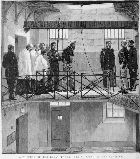Multimedia Content

Ned Kelly on the scaffold in the Old Melbourne Gaol, 20 November 1880, courtesy of State Library of Victoria.
Details
Capital Punishment
Eight years after the execution of Ronald Joseph Ryan on 3 February 1967, capital punishment was abolished in Victoria in 1975. Convicted of the murder of a gaol warden during a daring prison escape, Ryan became the last person executed in Australia. His death precipitated an ongoing legal and forensic debate over whether the bullet that shot the warder came from Ryan's gun.
Historically, the death penalty played a major role in Melbourne's intellectual and political life. Abolitionists like Vida Goldstein were prominent members of the city's social and cultural elite. Despite their efforts, Victoria preserved one of the most luxuriant collections of capital offences in the English-speaking world. Forms of attempted murder, rape, carnal knowledge of a girl under 10, sodomy, robbery and burglary with wounding, arson, together with the staples of murder and treason attracted the death penalty until 1949. By world standards, Victoria had a high execution rate. Between 1842 and 1975, 606 people were sentenced to death, 185 since Separation, with only 21 executions after 1900.
The decision to execute was ultimately a matter for the Governor-in-Council. The trial judge had little option but to don the black cap and pass the mandatory death sentence although, in non-homicide cases, there was an option of intimating a preference for leniency by merely 'recording' death. But the final decision was in the hands of the government of the day and was often highly controversial. Protesters would chant their views for or against capital punishment in Spring Street, and on the eve of an execution participate in vigils outside the (Old) Melbourne Gaol and later in Coburg streets surrounding Pentridge Prison. In some notorious cases, like that of multiple murderer Frederick Bailey Deeming in 1892, the clamour was for death. In others, public opinion was equivocal, particularly about executing women and Koorie people.
Of 45 women convicted of capital offences (17 of these for taking the lives of their own children), five were executed. Three of them, Frances Knorr ('the Brunswick baby-farmer'), Emma Williams (a prostitute who drowned her 2-year-old child) and Martha Needle ('the poisoner'), were executed in a short two-year period (1894-95) as part of a get tough on crime policy. Both the first and last execution of a woman, Elizabeth Scott in 1863 (for the murder of her husband) and Jean Lee, a prostitute, in 1951 (for the murder of an elderly client) involved a triple hanging, the women coming to grief for murders probably committed by one of their two co-accused.
Unlike other States in Australia, in Victoria there were some qualms about the morality of executing 'heathen' Aboriginal people. Calls for mercy were often explicitly racist; their 'savage instincts' and 'degraded ancestry' required that a different legal standard be applied. After the controversial first hanging in Port Phillip in 1842 of Roger (alias Tigara) for the murder of a white man, and the double execution in the same year of Bob Bob and Jack for burglary, wounding and the murder of two sailors, only three of the 28 Aboriginal people subsequently charged with capital offences had their sentences carried out.
Historically, recourse to the death penalty was a political ploy ruthlessly exploited, largely by conservative governments, for its purported electoral appeal. Sir Henry Bolte (Premier of Victoria responsible for the decision to hang Ryan) advised his successors to hold a hanging if they wanted to win an election. Current opinion poll evidence in Victoria, as elsewhere, suggests consistent but fluctuating majority support for the death penalty. Nevertheless, community attitudes to capital punishment have always been ambivalent, some of those executed having even acquired the status of folk heroes. Edward 'Ned' Kelly, a Glenrowan bushranger executed in 1880 for the attempted murder of a police constable, has grafted himself onto the national psyche. In his rough-hewn armour he has become a cultural icon representing the purportedly quintessential Australian virtues of mateship, larrikinism, anti-authoritarianism and stoic forbearance.
